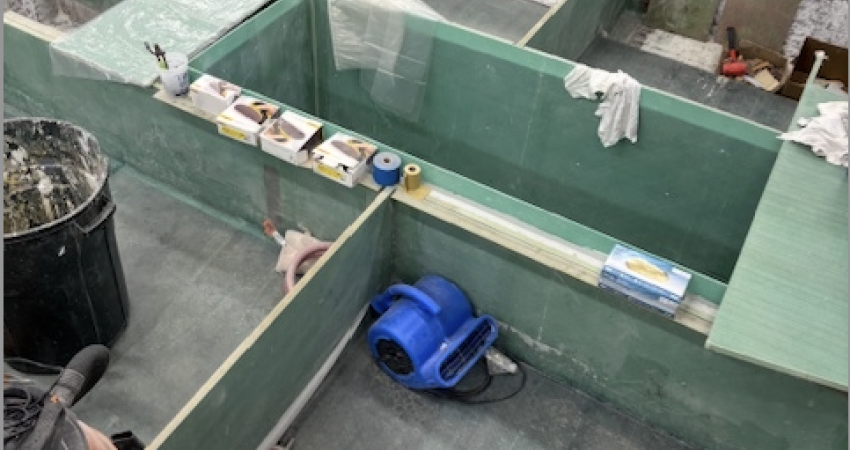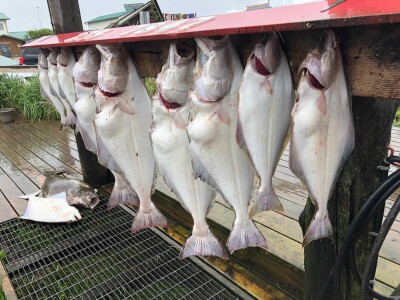In early April, Samoset Boatworks in Boothbay, Maine, was finishing up two 42’x14’ 6” Mussel Ridge tuna boats. The first one to be launched will be Pretty Work, going to Cape Cod, Mass., in mid- to late May.
It’s powered with a 900-hp Scania matched up to a Twin Disc 2.04:1 marine gear with a 5-blade, 34” square prop on a 2 ½” shaft. It should top out in the “mid to upper 20 mph range,” says Samoset Boatworks owner Matt Sledge.
The second tuna boat will head to Saunderstown, R.I., powered by a 1,150-hp Scania with a Twin Disc 2.17:1 gear and an undetermined prop size. That power combination should get it into the 30- to 31-mph range. “It’s more of a charter boat” than a full-time commercial fishing boat, notes Sledge, and hadn’t been given a name by mid-April.
The transom on the two boats has a center-line steering station, along with tuna doors to haul tuna aboard. Both boats also have in-deck live wells and an insulated tuna coffin – 8’6” long by 3’6” deep and a little less than 3’ wide. Pretty Work’s live well is insulated and will be refrigerated with an onboard ice machine, along with Pretty Work’s tuna coffin.
The tuna coffins and live wells play another role besides preserving the catch, for as Sledge will tell you.
“All the boats I build have live wells, tuna coffins or crib tanks. So, if it gets snotty out there you can ballast the boat down by filling up one or all the tanks and that plants the boat in the water. When it’s over, pump them out and you aren’t lugging all that weight around.”
The wheelhouse is similar on both boats, with a salon settee to port and “somewhat of a galley on the starboard, behind the helm chair with a microwave, fridge and freezer unit, and cabinets for storage,” said Sledge. Down below, both boats feature V-berths up forward, plus a single berth to starboard and a head with an enclosed shower to port.
“They are constructed the way I always do them,” Sledge added. That means the deck is made up of fiberglass I-beams, supporting 1-inch Coosa board that’s then fiberglassed and given a coating of SEM Products GripTide, a non-skid, two-part paint that contains ground-up rubber. “On tuna boats and pleasure boats it’s what I use,” said Sledge. “It’s gentle on bare feet and it does give good traction.”
When Pretty Work leaves Samoset Boatworks another Mussel Ridge 42 hull kit will show up. “This will be my fourth (42) in a row,” Sledge noted. He said the Mussel Ridge 42’s primary selling points include “the way the hull rides and the way the hull performs.” He attributes those features to the hard-chine hull.
“It’s one of two hard-chine boats. Wesmac and Mussel Ridge are the only two hard-chine Downeast hulls.” The hard-chine feature makes them a stable platform that’s also able to swing a 36”-diameter wheel, Sledge says, though “most of the time I’m throwing a 34” square (prop).”
A feature of Sledge’s boats is that he only uses epoxy coatings, no polyester. Thus, “my boats are lighter, stiffer and stronger” than if polyester coatings had been applied, he explains. With epoxy “you don’t need anything that’s mat backed. But with polyester, a mat backing is used all your cloth,” he says. “That adds weight, which affects speed and fuel usage.”
A case in point is a 48 Mussel Ridge built as a lobster boat that from a bare hull to out the Samoset Boatworks door required 2 1/4 drums of epoxy resin. “If that were polyester it would be 8 to 10 drums,” Sledge says.
With 800 gallons of fuel, the 48 Mussel Ridge “weighed just over 39,000 lbs. A similar boat finished off with polyester is over 50,000 lbs.,” says Sledge.







